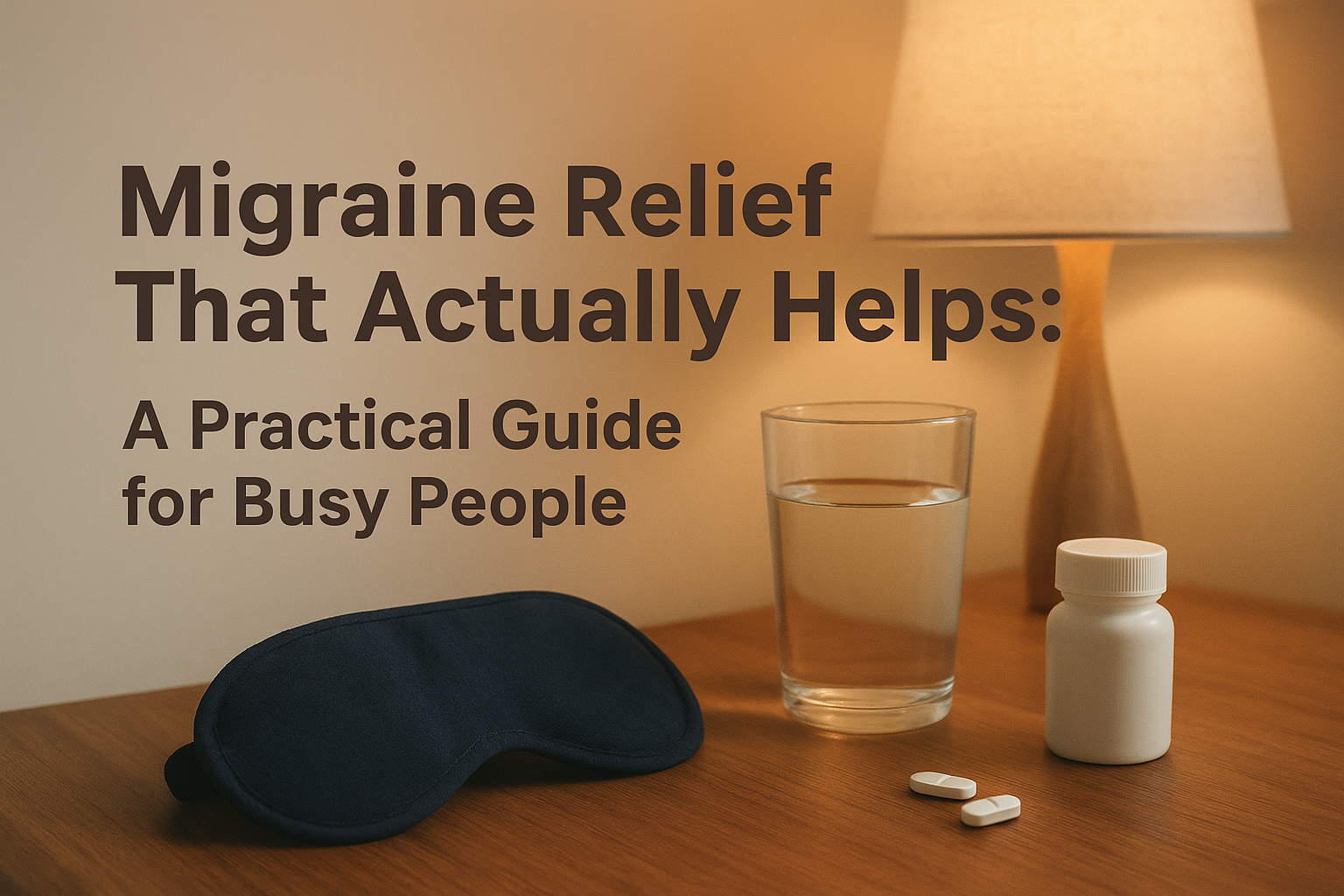
Key Takeaways
Why migraines happen—and what you can control
Migraines are a neurological condition, not “just headaches.” Attacks involve brain and nerve pathways that amplify pain, light/sound sensitivity, and nausea. You can’t control everything, but you can stack the odds in your favor with daily habits, a smart, acute plan, and—when needed—preventive options backed by current guidelines.
PMC
Part 1: Immediate Relief—Build a Personal “Attack Plan”
1. Treat early
Most acute meds work best if taken at the first sign (mild pain or aura). Keep your go-bag ready: water, meds, sunglasses/earplugs, and a small snack if nausea allows. Clinical guidance emphasizes timely treatment and setting realistic goals (e.g., pain freedom at 2 hours, minimal side effects).
PMC
2. Evidence-based options (discuss with your clinician)
- OTC first line: NSAIDs (e.g., ibuprofen, naproxen) or acetaminophen—especially effective when taken early. PMC
- Triptans (sumatriptan, rizatriptan, etc.): Mainstay for moderate–severe attacks; avoid with certain cardiovascular conditions. PMC
- Ditans (lasmiditan): Option when triptans aren’t suitable; may cause dizziness—avoid driving for 8 hours after use. PubMed
- Gepants (ubrogepant, rimegepant): CGRP receptor blockers used acutely; generally well tolerated. PubMed
- Antiemetics (e.g., metoclopramide): Helpful for nausea and to improve med absorption. (Guideline-based use.) PMC
- Neuromodulation devices:
- External trigeminal nerve stimulation (Cefaly) and single-pulse TMS (sTMS): FDA-cleared options with supportive evidence for some patients. The Migraine Trust
- Non-invasive vagus nerve stimulation (nVNS): Evidence supports both acute and preventive roles in selected cases. PMC+1
Use-limits to prevent rebound: Most triptans/combination analgesics = 9 days/month; NSAIDs/acetaminophen generally = 14 days/month—confirm limits for your meds to avoid medication-overuse headache.
American Migraine Foundation+1Part 2: Prevention That Works—From Habits to Modern Medicine
A. The SEEDS routine (daily)
- Sleep: Consistent bedtime/wake time; avoid weekend “jet lag.”
- Exercise: Aim for regular, moderate activity (e.g., brisk walks 30 min, 3–5×/week).
- Eat: Don’t skip meals; favor steady, balanced nutrition.
- Diary: Track sleep, stress, cycle, weather, and meds to spot patterns.
- Stress: Build a buffer—breathwork, CBT skills, or short mindfulness sessions. American Migraine Foundation+3American Headache Society+3
Reality check on triggers: Sleep changes, stress, menses, weather, and travel are common. Food triggers are less consistent than many think—test personally rather than banning entire categories.
American Migraine Foundation
B. Nutraceuticals with supportive evidence
- Magnesium: Often used as magnesium citrate/oxide; many clinicians target ~400–600 mg/day (watch GI tolerance). The Migraine Trust
- Riboflavin (B2): 400 mg/day for =3 months reduced attack frequency/severity in some studies. The Migraine Trust
- CoQ10: Around 300 mg/day showed benefit in trials and is AHS-endorsed as a reasonable option. American Headache Society+1 (Always clear supplements with your clinician—interactions and dosing vary.)
C. Prescription preventives
If you have >4 migraine days/month, significant disability, or can’t use acute meds, discuss preventives:
- CGRP-targeting therapies (first-line):
- Monoclonal antibodies: erenumab, fremanezumab, galcanezumab, eptinezumab (monthly or quarterly).
- Gepants (preventive): atogepant; rimegepant (also has acute dosing option). A 2024 American Headache Society position statement supports considering CGRP-targeting therapies as first-line preventives without requiring failure of older drugs. PubMed+2
- Other established options: beta-blockers, topiramate, certain antidepressants, candesartan—your clinician can tailor by comorbidities and side-effect profiles. (See AHS guideline resources.) American Headache Society
Part 3: Build Your Personal Plan (Printable Checklist)
With your clinician, decide:
- When to treat (e.g., at first symptom).
- Your acute path (OTC ? triptan/ditan/gepant; anti-nausea add-on).
- Monthly limits to avoid MOH. American Migraine Foundation
- Preventive choice (e.g., CGRP mAb or gepant) if criteria met. PubMed
- SEEDS goals (sleep window, exercise minutes, meal schedule, stress practice). American Migraine Foundation
- Nutraceuticals (dose, brand, start/stop date). The Migraine Trust
- Device trial if meds aren’t enough or aren’t tolerated. The Migraine Trust+1
Frequently Asked Questions
Are hormonal migraines different?
Many women notice perimenstrual peaks. Strategies include short-term prevention around menses (per clinician) plus SEEDS stability. (See AHS resources for individualized plans.)
American Headache Society
Do I need an elimination diet?
What if OTCs stopped working?
That may signal medication-overuse headache or the need for a stronger acute and/or preventive plan—time to check in with your clinician.
Merck Manuals
When to Seek Urgent Care (Red Flags)
- “Worst headache of life,” sudden onset
- New neurological symptoms (weakness, confusion, severe vision change)
- Head trauma, fever, stiff neck, cancer/immunosuppression, pregnancy/post-partum with new severe headache (These warrant same-day evaluation.)
How iLiveActive Can Help
- Guided SEEDS planner: Daily sleep/exercise/meal tracking with reminders
- Migraine diary template: Log triggers, meds, and relief scores (export for your clinician)
- Evidence hub: Always-updated references and patient-friendly summaries
References (selected)
- American Migraine Foundation—SEEDS lifestyle & diet resources. American Migraine Foundation+2
- American Headache Society—guidelines & 2024 position statement on CGRP first-line prevention. American Headache Society+2
- Acute treatment consensus & emerging options (ditans, gepants, devices). PMC+1
- Nutraceuticals (riboflavin, magnesium, CoQ10) evidence. The Migraine Trust+2
- Neuromodulation (nVNS, trigeminal stimulation, sTMS). PMC+2
- Medication-overuse headache recognition & management. ICHD-3+1